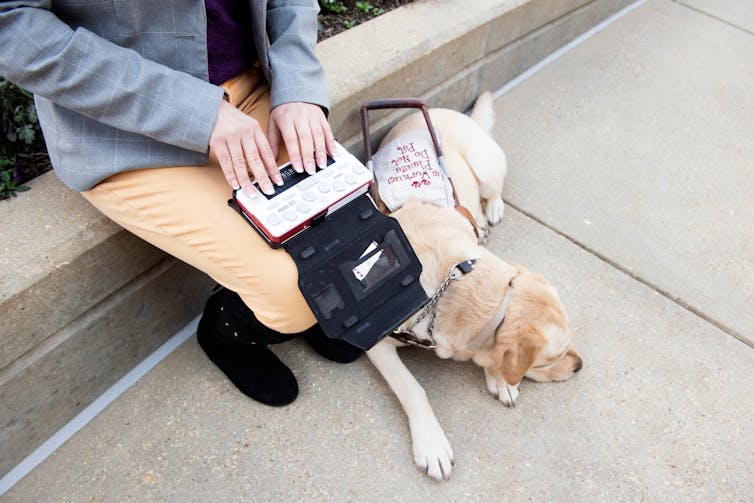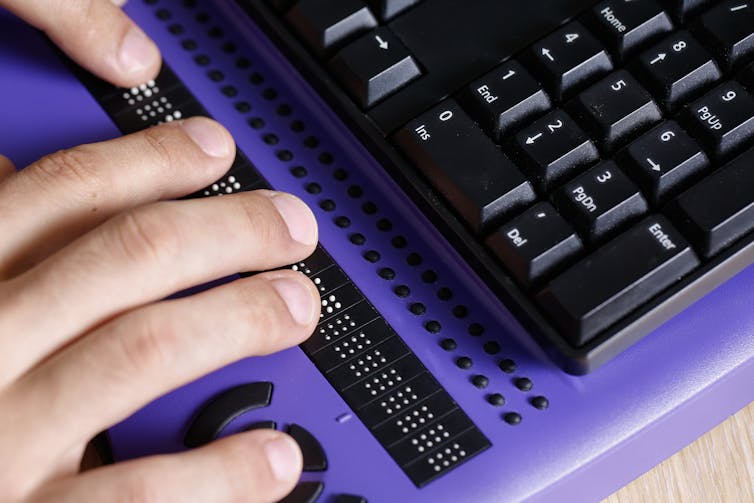Blind people have increased opportunities, but employers’ perceptions are still a barrier
- Written by Michele McDonnall, Research Professor and Director, Mississippi State University
Communities across the world observe White Cane Day[1] on Oct. 15 to recognize the contributions of people with blindness and low vision[2] and to promote equal opportunities. The day was first observed in the U.S. in 1964, when Congress passed a law[3] to increase awareness about the white cane’s role in promoting independent, safe travel for people with blindness or low vision.
More than 7.5 million Americans[4], or 2.4% of the population, are blind or have low vision. Some people are born with blindness or low vision, but most people acquire vision loss, often at older ages. Researchers estimate[5] that the incidence of blindness and low vision will rise rapidly through 2050 as the population ages.
As researchers[6] who study[7] issues related to blindness and low vision, we are interested in how society, its institutions, businesses and individuals currently perceive members of this population and how these perceptions may influence opportunities, particularly in terms of employment.
How the world has changed
 Technological advances have led to devices, such as this Braille notetaker, that can help people who are blind in the classroom and at work.
Megan Bean/Mississippi State University, CC BY-SA[8]
Technological advances have led to devices, such as this Braille notetaker, that can help people who are blind in the classroom and at work.
Megan Bean/Mississippi State University, CC BY-SA[8]
Since passage of that law 55 years ago, the world we live in has changed drastically. Advances in technology have significantly changed our everyday lives, and much progress in accessibility and inclusivity has occurred. Federal laws[9] that protect people with disabilities from employment discrimination have been passed, and many companies have since adopted inclusive hiring practices[10].
Assistive technology[11] such as screen readers and screen magnifiers improve access to information and jobs. Built-in accessibility features[12] in mainstream technologies are increasingly common. Accessible transportation options are continually evolving, including ride-hailing services[13] and autonomous vehicles[14].
These changes and innovations have increased opportunities and reduced some barriers for people who are blind or those who have low vision (for simplicity, we will use the term “blind” going forward).
Ongoing employment challenges
One thing that has not changed for many people who are blind is lack of access to the workforce. This is true for people with all types of disabilities, hence the celebration of National Disability Employment Awareness Month[15] in October. Our team of researchers at the National Research and Training Center on Blindness and Low Vision[16] is addressing this issue for people who are blind.
The large disparities in employment rates that have historically existed for people who are blind still exist today. The most recent data from the American Community Survey[17] indicates that 44.2% of people who are blind are employed and 10% are unemployed. This compares to an employment rate of 77.2% and unemployment rate of 4.8% for people without disabilities.
Why does employment continue to be a challenge for so many people who are blind? It may be that perceptions about the capabilities of the population have not changed.
Employer perceptions about blind people
One of the most common barriers to employment for people who are blind is negative employer attitudes. In several studies conducted between 2012 and 2017 with almost 1,000 employers, we measured employer attitudes and knowledge about how blind people can perform basic job functions. We included a measure of explicit (self-reported) attitudes toward individuals who are blind as employees and a measure of implicit attitudes[18] about the competence of people who are blind. Implicit attitudes refer to subconscious beliefs or stereotypes that a person may hold but not be aware of and thus would be unable to report.
Our research with employers revealed the following:
Our results verify the importance of employer attitudes toward blind people because of the association between attitudes and hiring. We know that knowledge is associated with more positive employer attitudes, but that knowledge is lacking among employers, and presumably among society in general. One potential avenue to improve employer attitudes is through increasing knowledge about how people who are blind function on the job. Most employers likely assume that a blind person cannot perform many essential job functions when in reality this is incorrect.
People who are blind can perform most jobs that sighted people can. There are not “jobs for blind people,” rather, most occupations in the economy are available to this population, given appropriate accommodations. You might be surprised to learn that people who are blind work in a variety of jobs[19].
They are architects[20], artists[21], auto mechanics[22], fashion designers[23], engineers[24], scientists[25], physicians[26] and judges[27]. Many jobs previously unavailable to people who are blind are now accessible thanks to advances in technology.
What people can do to open up opportunities
 Refreshable Braille displays are just one example of technological advances that have opened up job opportunities for people who are blind.
Zlikovec/Shutterstock.com[28]
Refreshable Braille displays are just one example of technological advances that have opened up job opportunities for people who are blind.
Zlikovec/Shutterstock.com[28]
Many employers have inaccessible job application sites[29], and people who are blind have filed lawsuits[30] regarding their inability to use a screen reader to access job-related information on websites. Giving this group of people equal access to learn about and apply for any job of interest is an important first step. Employers should make all digital information related to jobs accessible, including the application process. Accessibility is not difficult, and much support is available for this effort[31].
In addition, employers and society in general should learn about how people who are blind can perform tasks[32] for which sighted people rely on their vision. This is one of the best ways to change perceptions. Attending your local White Cane Day event is a great opportunity to learn about this population. Events such as this and National Disability Employment Awareness Month are important to increase awareness about the capabilities of people who are blind and the employment challenges they continue to face.
[ You’re smart and curious about the world. So are The Conversation’s authors and editors. You can read us daily by subscribing to our newsletter[33]. ]
References
- ^ White Cane Day (www.npr.org)
- ^ blindness and low vision (www.afb.org)
- ^ Congress passed a law (www.govinfo.gov)
- ^ 7.5 million Americans (factfinder.census.gov)
- ^ Researchers estimate (doi.org)
- ^ As researchers (scholar.google.com)
- ^ who study (scholar.google.com)
- ^ CC BY-SA (creativecommons.org)
- ^ Federal laws (www.ada.gov)
- ^ inclusive hiring practices (disabilityin.org)
- ^ Assistive technology (www.loc.gov)
- ^ Built-in accessibility features (www.cnet.com)
- ^ ride-hailing services (www.afb.org)
- ^ autonomous vehicles (doi.org)
- ^ National Disability Employment Awareness Month (www.dol.gov)
- ^ National Research and Training Center on Blindness and Low Vision (www.blind.msstate.edu)
- ^ most recent data from the American Community Survey (factfinder.census.gov)
- ^ measure of implicit attitudes (implicit.harvard.edu)
- ^ variety of jobs (www.ntac.blind.msstate.edu)
- ^ architects (www.ntac.blind.msstate.edu)
- ^ artists (bramblitt.com)
- ^ auto mechanics (www.cbsnews.com)
- ^ fashion designers (twoblindbrothers.com)
- ^ engineers (www.cnbc.com)
- ^ scientists (www.ntac.blind.msstate.edu)
- ^ physicians (www.nbcnews.com)
- ^ judges (www.huffpost.com)
- ^ Zlikovec/Shutterstock.com (www.shutterstock.com)
- ^ Many employers have inaccessible job application sites (uxpajournal.org)
- ^ lawsuits (www.shrm.org)
- ^ support is available for this effort (www.w3.org)
- ^ learn about how people who are blind can perform tasks (www.ntac.blind.msstate.edu)
- ^ You can read us daily by subscribing to our newsletter (theconversation.com)
Authors: Michele McDonnall, Research Professor and Director, Mississippi State University

